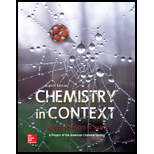
(a)
Interpretation:
- • The three disadvantages in the opening photograph of the chapter have to be listed.
- • The omitted and lost chemical details in the opening photograph of the chapter have to be found.
Concept Introduction:
DNA:
DNA is a self-replicating genetic material that is present in all living organisms. It carries genetic information from one generation to the several successive generations. Basically it is a biopolymer of nucleotides which are monomeric units and each monomeric unit has three major components such as a deoxyribose sugar unit, a phosphate group and a nitrogen-containing base.
(b)
Interpretation:
- • The three advantages in the opening photograph of the chapter have to be listed.
- • The highlighted information in the opening photograph of the chapter has to be found.
- • The gained information in the opening photograph of the chapter has to be found.
Concept Introduction:
DNA:
DNA is a self-replicating genetic material that is present in all living organisms. It carries genetic information from one generation to the several successive generations. Basically it is a biopolymer of nucleotides which are monomeric units and each monomeric unit has three major components such as a deoxyribose sugar unit, a phosphate group and a nitrogen-containing base.
(c)
Interpretation:
The artistic rendition of DNA that could be possibly found around has to be found.
Concept Introduction:
DNA:
DNA is a self-replicating genetic material that is present in all living organisms. It carries genetic information from one generation to the several successive generations. Basically it is a biopolymer of nucleotides which are monomeric units and each monomeric unit has three major components such as a deoxyribose sugar unit, a phosphate group and a nitrogen-containing base.
Want to see the full answer?
Check out a sample textbook solution
Chapter 12 Solutions
Chemistry in Context
- Provide the missing information. *see imagearrow_forwardDraw the mechanism (including all curved arrows for electron movement) showing how the maleicanhydride is attacked by the anthracene and formation of the final Diels Alder product.arrow_forwardProvide the missing information. *see imagearrow_forward
- Provide the missing information. *see imagearrow_forwardProvide the missing information. *see imagearrow_forwardI have a bottle of butanal that has been improperly used by lab workers. They allowed a traceamount NaOH (aq) to contaminate the bottle. What is now in my bottle of “butanal? What is the molecular name and functional group name? Draw the structure.arrow_forward
- Provide the missing information. *see imagearrow_forwardFirst image: Why can't the molecule C be formed in those conditions Second image: Synthesis for lactone C its not an examarrow_forwardFirst image: I have to show the mecanism for the reaction on the left, where the alcohol A is added fast in one portion Second image: I have to show the mecanism of the reaction at the bottom. Also I have to show by mecanism why the reaction wouldn't work if the alcohol was primaryarrow_forward
 Introductory Chemistry: A FoundationChemistryISBN:9781285199030Author:Steven S. Zumdahl, Donald J. DeCostePublisher:Cengage Learning
Introductory Chemistry: A FoundationChemistryISBN:9781285199030Author:Steven S. Zumdahl, Donald J. DeCostePublisher:Cengage Learning ChemistryChemistryISBN:9781305957404Author:Steven S. Zumdahl, Susan A. Zumdahl, Donald J. DeCostePublisher:Cengage Learning
ChemistryChemistryISBN:9781305957404Author:Steven S. Zumdahl, Susan A. Zumdahl, Donald J. DeCostePublisher:Cengage Learning Chemistry: An Atoms First ApproachChemistryISBN:9781305079243Author:Steven S. Zumdahl, Susan A. ZumdahlPublisher:Cengage Learning
Chemistry: An Atoms First ApproachChemistryISBN:9781305079243Author:Steven S. Zumdahl, Susan A. ZumdahlPublisher:Cengage Learning Chemistry: Matter and ChangeChemistryISBN:9780078746376Author:Dinah Zike, Laurel Dingrando, Nicholas Hainen, Cheryl WistromPublisher:Glencoe/McGraw-Hill School Pub Co
Chemistry: Matter and ChangeChemistryISBN:9780078746376Author:Dinah Zike, Laurel Dingrando, Nicholas Hainen, Cheryl WistromPublisher:Glencoe/McGraw-Hill School Pub Co Chemistry: Principles and PracticeChemistryISBN:9780534420123Author:Daniel L. Reger, Scott R. Goode, David W. Ball, Edward MercerPublisher:Cengage Learning
Chemistry: Principles and PracticeChemistryISBN:9780534420123Author:Daniel L. Reger, Scott R. Goode, David W. Ball, Edward MercerPublisher:Cengage Learning





